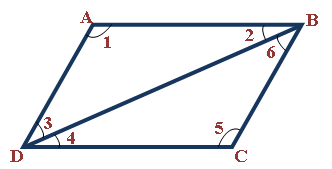Diagonal of a Parallelogram Which Bisects One Angle It Bisects The Second Angles










Diagonal of a Parallelogram Which Bisects One Angle It Bisects The Second Angles
Diagonal of a Parallelogram Which Bisects One Angle Bisects The other Angle: We know that a parallelogram is a quadrilateral in which pair of opposite side is equal and parallel, but its diagonal bisects the angles of the parallelogram then that parallelogram is a rhombus.
Theorem: If diagonal of a parallelogram bisects one of the angles of the parallelogram, it also bisects the second angles. Also, prove that it is a rhombus.
GIVEN A parallelogram ABCD in which diagonal AC bisects <A.
To prove AC bisects <C
Proof Since ABCD is a parallelogram. Therefore, AB Now, AB
Again, AD
But, it is given that BD is the bisector of <B. Therefore, <2 = <6 ....(iii) From (i), (ii) and (iii) , we get <3 = <4 .....(iv)Hence, BD bisects <D. In a parallelogram <B = <D [Opposite angles are equal] < 2 = <3 But, AB = DC anf BC = AD [
Hence, ABCD is a rhombus. |  |
ILLUSTRATION: ABCD is a rhombus with , then find the value of
Solution: ABCD is a rhombus and each rhombus is a parallelogram AB || CD and BC is the transversal
Now we know that the diagonal bisects both the angles of a rhombus
From the figure |  |
In the following figure, ABCD is a parallelogram. The diagonal BD bisects
| |||
| Right Option : C | |||
| View Explanation | |||
In the following figure, the diagonal AC bisects
| |||
| Right Option : B | |||
| View Explanation | |||
ABCD is a rhombus with | |||
| Right Option : A | |||
| View Explanation | |||
Students / Parents Reviews [10]
I have spent a wonderful time in Abhyas academy. It has made my reasoning more apt, English more stronger and Maths an interesting subject for me. It has given me a habbit of self studying

Yatharthi Sharma
10thIt was good as the experience because as we had come here we had been improved in a such envirnment created here.Extra is taught which is beneficial for future.

Eshan Arora
8thBeing a parent, I saw my daughter improvement in her studies by seeing a good result in all day to day compititive exam TMO, NSO, IEO etc and as well as studies. I have got a fruitful result from my daughter.

Prisha Gupta
8thMy experience with Abhyas is very good. I have learnt many things here like vedic maths and reasoning also. Teachers here first take our doubts and then there are assignments to verify our weak points.

Shivam Rana
7thOne of the best institutes to develope a child interest in studies.Provides SST and English knowledge also unlike other institutes. Teachers are co operative and friendly online tests andPPT develope practical knowledge also.

Aman Kumar Shrivastava
10thMy experience was very good with Abhyas academy. I am studying here from 6th class and I am satisfied by its results in my life. I improved a lot here ahead of school syllabus.

Ayan Ghosh
8thAbhyas is a complete education Institute. Here extreme care is taken by teacher with the help of regular exam. Extra classes also conducted by the institute, if the student is weak.

Om Umang
10thMy experience with Abhyas academy is very good. I did not think that my every subject coming here will be so strong. The main thing is that the online tests had made me learn here more things.

Hiya Gupta
8thAbhyas Methodology is very good. It is based on according to student and each child manages accordingly to its properly. Methodology has improved the abilities of students to shine them in future.

Manish Kumar
10thIt was a good experience with Abhyas Academy. I even faced problems in starting but slowly and steadily overcomed. Especially reasoning classes helped me a lot.


